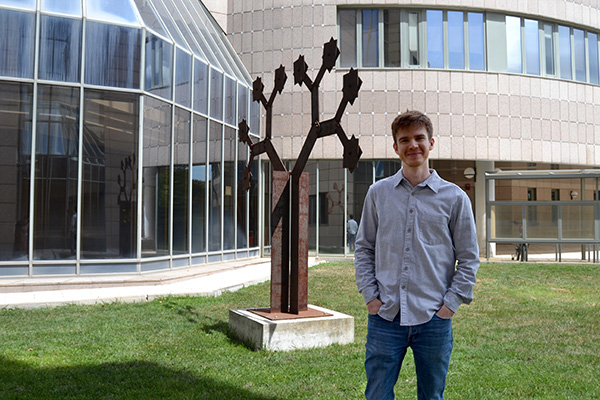Fernando Peñaranda is defending his PhD Thesis on April, 19 at ICMM: "My work will help to prove the existence of the so-far-elusive Majorana Bound States"
The scientific has been working with ICMM's researchers Elsa Prada and Pablo San-José.
 Researcher Fernando Peñaranda has an appointment next Wednesday, April, 19, at Main Hall at Materials Science Institute of Madrid (ICMM), CSIC, as he is going to defend his Ph.D. thesis entitled 'Topological superconductivity in nanowires and two-dimensional crystals'. His work has been directed by ICMM's researchers Elsa Prada and Pablo San-José. In this interview, he explains why is so important the investigation he has done through these years.
Researcher Fernando Peñaranda has an appointment next Wednesday, April, 19, at Main Hall at Materials Science Institute of Madrid (ICMM), CSIC, as he is going to defend his Ph.D. thesis entitled 'Topological superconductivity in nanowires and two-dimensional crystals'. His work has been directed by ICMM's researchers Elsa Prada and Pablo San-José. In this interview, he explains why is so important the investigation he has done through these years.
Why did you choose ICMM for your Ph.D.?
Upon completion of my master, it became evident to me that I wanted to further my education by pursuing a Doctorate in theoretical condensed matter physics. The members of the Teoría de Materiales Cuánticos y Tecnologías Cuánticas de Estado Sólido group immediately captured my attention due to their proficiency in both numerical and analytical approaches to the description of such systems.
How would you explain your research to a non-scientific audience?
My research deals with the theoretical description of the collective properties of electrons in nanoscale systems and, in particular, with the modes that arise in an exotic electronic phase in hybrid superconducting and semiconducting devices: the so-called Majorana bound states.
These states are highly unconventional as they possess truly exotic properties. For instance, a pair of them is predicted to encode a (quasi-) particle that is maximally delocalized. These two modes are located as far apart from each other as possible and, in one-dimensional systems, live at two opposite edges. In addition, these states are immune to generic perturbations, making them ideal for technological applications. Despite being predicted for some time, no conclusive evidence of their existence has been reported to date. This thesis addresses the reasons underlying their elusiveness, by proposing alternate systems that can also host them, and new experimental protocols to detect them. All the previous is done with the hope that it will help to prove the existence of the so-far-elusive Majorana Bound States.
What are the main applications of your research? Could you give us an example?
Besides being extremely appealing from a theoretical viewpoint, the aforementioned properties of such states make them ideal candidates to form the elementary units of a fault-tolerant quantum computer, not affected by decoherence, which is the most challenging issue in most current proposals.
How do you think this experience will contribute to your training and to your future?
Completing my thesis has been an incredibly valuable experience that I believe will greatly contribute to both my training and my future career. Throughout my research, I have gained a deep understanding of the fundamental principles and theories of my field, as well as the technical skills required to conduct new projects. Moreover, I have had the opportunity to collaborate with and learn from many researchers in the field, both from the theoretical and experimental sides, which has exposed me to new ideas and perspectives. Overall, I believe that this experience has equipped me with a great set of tools for my next steps in research.
What are your plans once you finish your PhD?
As I have deeply enjoyed conducting research in this field, I have decided to continue my career in academia by pursuing a postdoctoral position that will be focused on moiré superlattices.
-- Ángela R. Bonachera (ICMM Communication Unit) --
Instituto de Ciencia de Materiales de Madrid (ICMM)
Sor Juana Ines de la Cruz, 3
Cantoblanco, 28049
Madrid, España
Telephone: (+34) 91 334 90 00
Email: @email
Communication Office: @email

Acknowledge the Severo Ochoa Centres of Excellence program through Grant CEX2024-001445-S/ financiado por MICIU/AEI / 10.13039/501100011033

Contacto | Accesibilidad | Aviso legal | Política de Cookies | Protección de datos